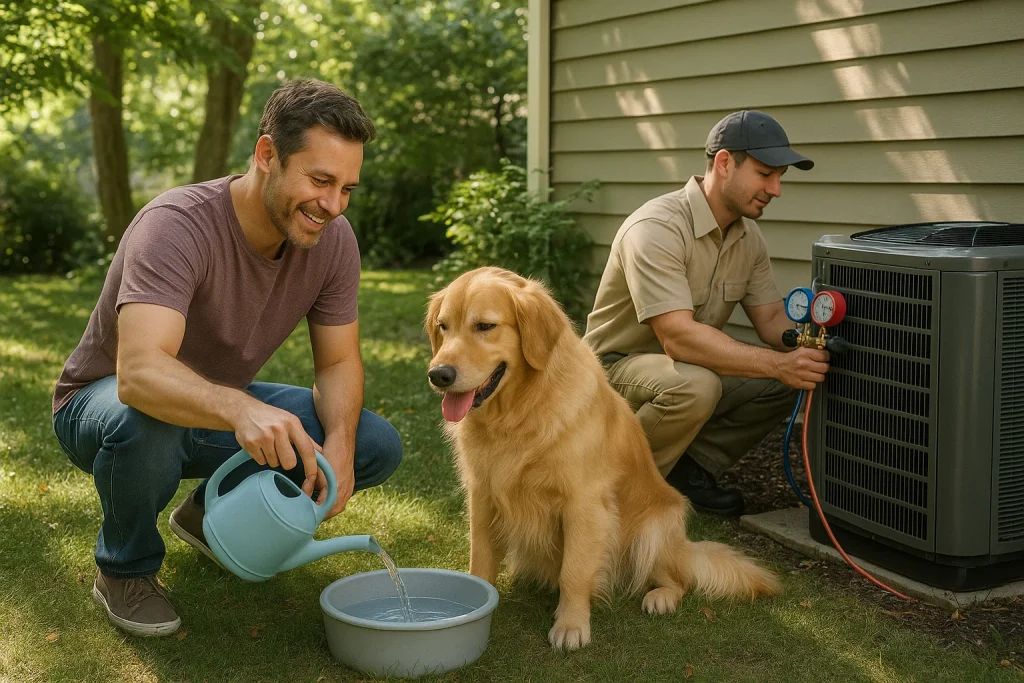As HVAC professionals, we’re all about keeping your home cool and comfortable—but that comfort shouldn’t stop with the humans in your household. Summer heat can be especially hard on pets, who don’t have the same cooling mechanisms we do.
Whether your furry friend is a dog, cat, or another animal companion, it’s important to keep them safe when temperatures rise. Here are some essential heat safety tips to protect your pets this summer, both indoors and out.

1. Keep Your Home Cool and Comfortable
Your home’s HVAC system plays a huge role in protecting your pets from heat stress. Make sure your air conditioning is working properly and keeping indoor temperatures safe. Pets, especially those with thick coats or underlying health conditions, can easily overheat in a stuffy house.
- Set your thermostat to a consistent, pet-friendly temperature. Generally, 76–78°F is a good range for most pets.
- Use ceiling fans to circulate air, but remember, fans don’t cool pets the same way they cool people. They help only if the room is already air-conditioned.
- Schedule regular HVAC maintenance to avoid mid-summer breakdowns that could leave your pets vulnerable.
2. Never Leave Pets in a Parked Car
Even if it’s “just for a few minutes,” temperatures inside a parked car can skyrocket in no time, even with the windows cracked. On an 85°F day, the interior of a car can reach over 100°F in less than 10 minutes. This creates a dangerous and potentially deadly environment for pets. If you’re running errands, it’s always safest to leave your pets at home in the comfort of your air-conditioned house.
3. Provide Plenty of Fresh Water
Hydration is key during hot weather. Pets can quickly become dehydrated, especially if they’re active or spend time outdoors.
- Change their water bowl frequently throughout the day.
- Add ice cubes to their bowl for an extra cooling boost.
- Consider a pet water fountain to encourage drinking and keep water fresh.
4. Be Mindful of Outdoor Temperatures and Surfaces
Outdoor playtime is important, but it should be timed carefully during the summer months. Avoid walks and play during peak heat, typically between 10 a.m. and 4 p.m. Test pavement with your hand—if it’s too hot for your palm, it’s too hot for paws.
Provide access to shaded areas and limit time spent outdoors, especially for brachycephalic (flat-faced) breeds like pugs and bulldogs that struggle to cool themselves.
5. Watch for Signs of Heat Stress in Pets
Just like people, pets can suffer from heat exhaustion and heatstroke. Keep an eye out for:
- Excessive panting or drooling
- Lethargy or weakness
- Vomiting or diarrhea
- Bright red gums or tongue
- Difficulty breathing
If you notice these symptoms, move your pet to a cool area immediately and contact your vet. Acting quickly can save your pet’s life.
6. Grooming and Summer Coats
While it may seem like shaving your pet’s coat would help in the heat, many animals rely on their fur for insulation against both cold and heat. Brush your pet regularly to remove excess undercoat and prevent matting, which traps heat. Ask your vet or groomer for breed-appropriate grooming advice for summer.
Contact Althoff Home Services today to schedule an appointment with our professionals. Chicago’s Choice Since 1961. Hand It Off to Althoff!
